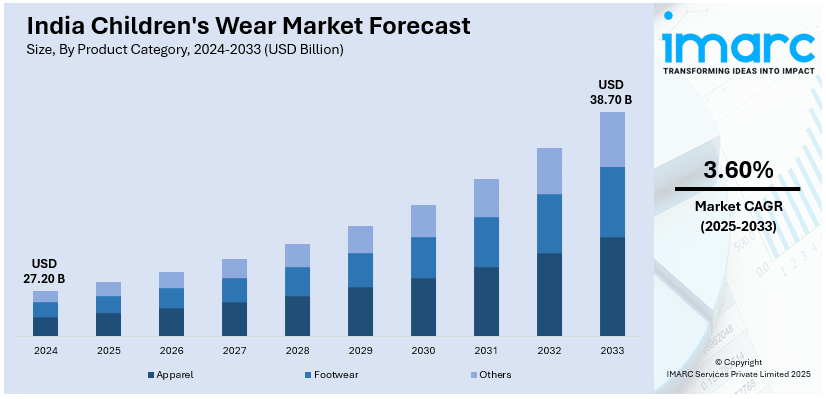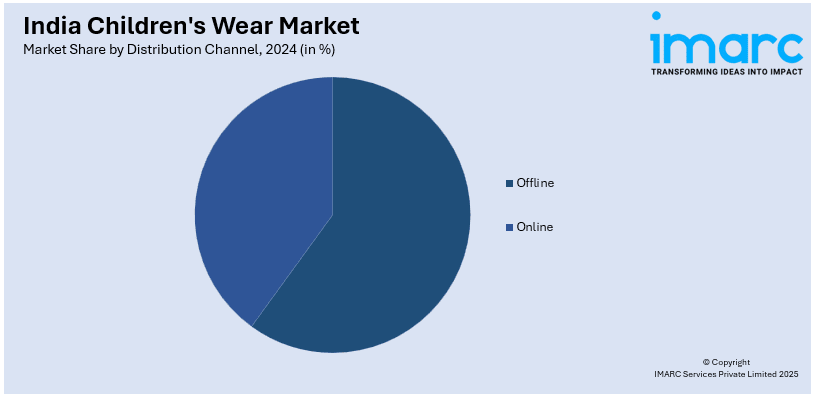
India Children's Wear Market Size, Share, Trends and Forecast by Product Category, Consumer Group, Gender, Distribution Channel, and Region, 2025-2033
India Children's Wear Market Overview:
The India children’s wear market size reached USD 27.20 Billion in 2024. Looking forward, IMARC Group expects the market to reach USD 38.70 Billion by 2033, exhibiting a growth rate (CAGR) of 3.60% during 2025-2033. The market is experiencing significant growth mainly due to rising disposable income, increasing urbanization and evolving fashion trends. Rapid e-commerce penetration and social media influence along with strong consumer demand are also contributing positively to the market growth.
|
Report Attribute
|
Key Statistics
|
|---|---|
|
Base Year
|
2024 |
|
Forecast Years
|
2025-2033
|
|
Historical Years
|
2019-2024
|
| Market Size in 2024 | USD 27.20 Billion |
| Market Forecast in 2033 | USD 38.70 Billion |
| Market Growth Rate 2025-2033 | 3.60% |
India Children's Wear Market Trends:
Rising Disposable Income
Higher disposable income among Indian households is fueling demand for branded and premium children's clothing, as parents prioritize quality, style, and comfort over generic alternatives. This shift is significantly contributing to India children's wear market growth, with increased spending on kids’ apparel across urban and semi-urban areas. According to the report published by IBEF, India's disposable per capita income increased from US$ 2.11 thousand in 2019 to US$ 2.54 thousand in 2023, with projections reaching US$ 4.34 thousand by 2029. This rising income is transforming consumer spending patterns, especially in rural areas, where more individuals are investing in non-food products beyond essentials. Affluent consumers are seeking fashionable, durable, and ethically produced clothing, driving sales for both domestic and international brands. The expansion of premium and designer kidswear collections, along with personalized clothing options, is further boosting the market. Additionally, aspirational buying behavior, fueled by social media influence and global fashion trends, is pushing retailers to offer exclusive, high-end collections. As affordability increases across income segments, branded children's wear is becoming mainstream beyond metro cities. These factors are strengthening brand loyalty, increasing average spending per child, and expanding the consumer base, ultimately driving India children's wear market share in both online and offline retail segments.

To get more information on this market, Request Sample
Sustainability and Organic Fabrics
Growing awareness regarding environmental sustainability and child health is driving demand for eco-friendly and organic fabrics in the India children's wear market. Parents are increasingly opting for organic cotton, bamboo fiber, and chemical-free clothing, prioritizing skin-friendly materials over synthetic alternatives. Concerns over allergies, rashes, and harmful dyes are influencing purchasing decisions, leading to a surge in demand for GOTS-certified (Global Organic Textile Standard) and OEKO-TEX®-approved fabrics. Brands are responding with sustainable collections, focusing on biodegradable fabrics, ethical sourcing, and non-toxic dyes. Additionally, eco-conscious packaging and slow fashion trends are gaining traction, reinforcing sustainable consumption patterns. Major players and startups are capitalizing on this shift by introducing premium organic kidswear lines. For instance, in September 2024, PILOLO, a fresh kids' clothing brand from the UAE, debuted its organic line in India during Junior’s Fashion Week in Mumbai. Aiming at kids aged 4 to 9, the brand promotes a playful philosophy with its tagline, "Stay Silly," encouraging creativity and curiosity in children. With increasing regulatory focus on sustainable textiles and growing consumer preference for organic clothing, the India children's wear market outlook remains positive, with sustainability emerging as a key growth driver.
India Children's Wear Market Segmentation:
IMARC Group provides an analysis of the key trends in each segment of the market, along with forecasts at the regional level for 2025-2033. Our report has categorized the market based on product category, consumer group, gender and distribution channel.
Product Category Insights:
- Apparel
- Footwear
- Others
The report has provided a detailed breakup and analysis of the market based on the product category. This includes apparel, footwear and others.
Consumer Group Insights:
- Infant (0-12 Months)
- Toddler (1-3 Years)
- Preschool (3-5 Years)
- Gradeschooler (5-12 Years)
A detailed breakup and analysis of the market based on the consumer group have also been provided in the report. This includes infant (0-12 months), toddler (1-3 years), preschool (3-5 years), and gradeschooler (5-12 years).
Gender Insights:
- Boys
- Girls
- Unisex
A detailed breakup and analysis of the market based on the gender have also been provided in the report. This includes boys, girls and unisex.
Distribution Channel Insights:

- Offline
- Online
A detailed breakup and analysis of the market based on the distribution channel have also been provided in the report. This includes offline and online.
Regional Insights:
- North India
- South India
- East India
- West India
The report has also provided a comprehensive analysis of all the major regional markets, which include North India, South India, East India and West India.
Competitive Landscape:
The market research report has also provided a comprehensive analysis of the competitive landscape. Competitive analysis such as market structure, key player positioning, top winning strategies, competitive dashboard, and company evaluation quadrant has been covered in the report. Also, detailed profiles of all major companies have been provided.
India Children's Wear Market News:
- In February 2024, Premium kidswear brand Kate and Oscar opened its latest store in Ambience Mall, Gurgaon, marking its sixth location in India. With plans to establish 30 stores in major metros within three years, the brand focuses on upscale children’s fashion and aims to enhance its online presence alongside brick-and-mortar growth.
- In January 2024, Shilpa Shetty Kundra launched Zip Zap Zoop, a sustainable kidswear line in collaboration with Ashmika Sadh. Featuring 500 styles for ages 0-19, the brand focuses on comfort, individuality, and eco-friendly materials. Committed to transparency and ethical production, it aims to redefine children's fashion while promoting social and environmental responsibility.
India Children's Wear Market Report Coverage:
| Report Features | Details |
|---|---|
| Base Year of the Analysis | 2024 |
| Historical Period | 2019-2024 |
| Forecast Period | 2025-2033 |
| Units | Billion USD |
| Scope of the Report |
Exploration of Historical Trends and Market Outlook, Industry Catalysts and Challenges, Segment-Wise Historical and Future Market Assessment:
|
| Product Categories Covered | Apparel, Footwear, Others |
| Consumer Groups Covered | Infant (0-12 Months), Toddler (1-3 Years), Preschool (3-5 Years), Gradeschooler (5-12 Years) |
| Gender Covered | Boys, Girls, Unisex |
| Distribution Channels Covered | Offline, Online |
| Regions Covered | North India, South India, East India, West India |
| Customization Scope | 10% Free Customization |
| Post-Sale Analyst Support | 10-12 Weeks |
| Delivery Format | PDF and Excel through Email (We can also provide the editable version of the report in PPT/Word format on special request) |
Key Benefits for Stakeholders:
- IMARC’s industry report offers a comprehensive quantitative analysis of various market segments, historical and current market trends, market forecasts, and dynamics of the India children’s wear market from 2019-2033.
- The research report provides the latest information on the market drivers, challenges, and opportunities in the India children’s wear market.
- Porter's five forces analysis assist stakeholders in assessing the impact of new entrants, competitive rivalry, supplier power, buyer power, and the threat of substitution. It helps stakeholders to analyze the level of competition within the India children’s wear industry and its attractiveness.
- Competitive landscape allows stakeholders to understand their competitive environment and provides an insight into the current positions of key players in the market.
Key Questions Answered in This Report
The children’s wear market in India was valued at USD 27.20 Billion in 2024.
The India children’s wear market is projected to exhibit a CAGR of 3.60% during 2025-2033, reaching a value of USD 38.70 Billion by 2033.
Key elements driving the Indian children’s apparel market consist of rising disposable incomes, heightened brand awareness among parents, and an expanding youth demographic. Moreover, the impact of social media, swift growth of e-commerce channels, and the need for stylish, comfy, and eco-friendly apparel are supporting the market growth.
Need more help?
- Speak to our experienced analysts for insights on the current market scenarios.
- Include additional segments and countries to customize the report as per your requirement.
- Gain an unparalleled competitive advantage in your domain by understanding how to utilize the report and positively impacting your operations and revenue.
- For further assistance, please connect with our analysts.
 Request Customization
Request Customization
 Speak to an Analyst
Speak to an Analyst
 Request Brochure
Request Brochure
 Inquire Before Buying
Inquire Before Buying




.webp)




.webp)












